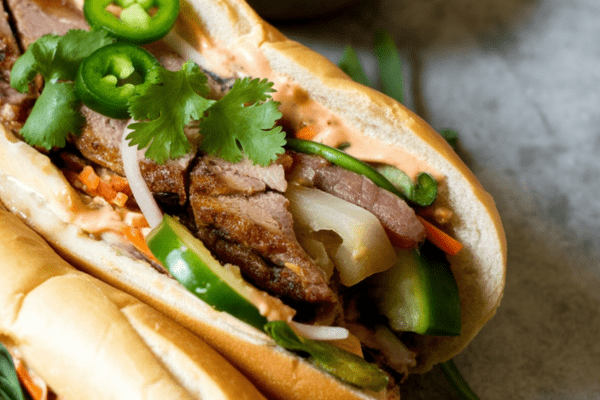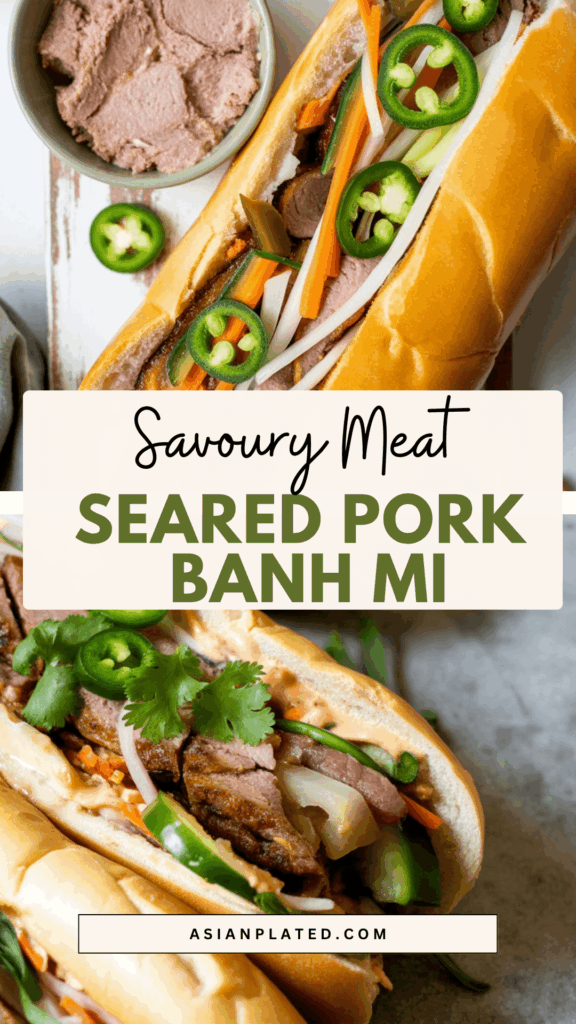If there’s one thing I never get tired of eating (or talking about), it’s sandwiches. I genuinely think they don’t get the love they deserve. The Vietnamese banh mi is proof of just how brilliant a sandwich can be—crispy, fluffy bread stuffed with savory meat, fresh herbs, and bright pickles.

Whenever I want something special but not too fussy, this lemongrass pork banh mi hits the spot. It’s one of those meals that feels like street food adventure right at your own table. The best part? You can make this version in under an hour—though I’m warning you, you’ll be craving it again the next day.
What Makes Banh Mi So Irresistible
The word banh mi literally means “bread” in Vietnamese, but if you’ve ever had one, you know it’s so much more than that. It’s a true mash-up of French and Vietnamese influences—baguettes introduced during colonial times, layered with local flavors and ingredients.
I first fell in love with banh mi at a tiny shop tucked away on a crowded city street. They’d hand you a warm, crackly loaf stuffed with all these contrasting textures and flavors. That memory is what I try to recreate at home.
In many cities, especially in the US, banh mi is the go-to for a quick, filling lunch with personality. Once you try making it yourself, you’ll see why it’s become such a staple.

What Goes Into a Classic Banh Mi
A really good banh mi is all about balance. You’ve got savory protein, crisp pickled veggies, fresh herbs, creamy spreads, and a bit of heat.
The basics I always include:
- Some kind of protein—here, we’re doing lemongrass pork, which is one of my personal favorites for its deep, fragrant flavor.
- Pickled carrots and daikon—these brighten everything up. I make them in batches and keep them in the fridge for sandwiches and rice bowls.
- Sliced cucumber and jalapeño—cool and spicy in one bite.
- Cilantro—unless you’re one of those people who think it tastes like soap (and that’s okay—you can skip it).
- Vietnamese pâté and mayonnaise—a rich nod to the French roots that makes every bite creamy and savory.
- All of it stuffed inside a crackly baguette with that light, airy interior.
It’s the kind of sandwich you eat with both hands and plenty of napkins.

Choosing Your Protein: Tips From My Kitchen
Lemongrass pork is my go-to for this recipe because it’s so aromatic and satisfying. I usually buy pork shoulder because it has that lovely balance of fat and meat that makes for juicy, flavorful bites.
If you’re feeling experimental or need to use what you have:
- Pork belly: Even richer. Great for days you want something extra indulgent.
- Pork butt: Another solid option.
- Lean cuts: You can use pork loin or chops if you want less fat, but honestly, I think you lose some of that melt-in-your-mouth quality.
My kitchen always has garlic and fish sauce on hand for marinades—those two alone can transform the flavor. I don’t skimp on dark brown sugar either. That subtle sweetness caramelizes beautifully.
Bread Matters: My Thoughts
I’m pretty picky about the bread. Vietnamese baguettes have that signature lightness thanks to rice flour—thin crackly crust, fluffy inside.
If you can get Vietnamese-style baguettes from a bakery or Asian grocery, do it. But let’s be honest: sometimes you just grab what you can. A French baguette from the grocery store will work fine in a pinch.
One trick I use is to warm the bread in the oven for a few minutes to revive that crisp crust before filling. It makes a big difference.
Filling Ingredients: My Favorite Choices
Cha lua is a classic Vietnamese pork sausage. It’s not for everyone, I know—it’s got a distinct flavor. I like picking it up at the Asian market, but if you’re new to it or not a fan, you can leave it out without ruining the sandwich.
Pâté and mayonnaise are the real secret weapons. You can use any store-bought pâté you like, but I lean toward the spreadable ones. For mayo, I love using Japanese-style (like Kewpie) for its richer, eggier flavor.
Fresh vegetables—cilantro, cucumbers, jalapeños—bring everything to life. And don’t forget the pickled daikon and carrot. They’re the bright, crunchy contrast that makes banh mi so addictive. I always keep a jar in the fridge ready to go.
Prepping the Lemongrass Pork
I treat marinating as a form of patience therapy. Ideally, I let the pork soak overnight, especially if I’m planning ahead. But if I’m in a rush (which is often), even 30 minutes will do wonders.
My marinade is simple: minced lemongrass, garlic, fish sauce, sugar, oil, pepper. It smells incredible before it even hits the pan.
When cooking, I use a cast iron grill pan if I want char marks, but a regular pan works fine. I sear it hot and fast—just a couple of minutes per side. The sugars in the marinade caramelize, leaving you with a sticky, deeply flavored exterior.
Assembling Your Perfect Banh Mi
This is where the fun happens. I lay everything out on the counter so it feels like a mini sandwich station.
Here’s my personal method:
- Slice the baguette most of the way through so you can open it up like a book.
- Spread pâté on one side and mayo on the other. Don’t be stingy.
- Add the warm, fragrant lemongrass pork.
- Layer on thinly sliced cha lua (if you’re using it).
- Pile on pickled daikon and carrot, cucumbers, cilantro, jalapeños.
I press it lightly to keep it all together and dig in immediately. The contrast of warm pork, cold pickles, and soft bread is unbeatable.
My Best Tips for Flavors That Pop
- Marinate overnight if you can. The flavor is deeper and more cohesive. It’s how my mom always did it.
- Use fresh baguettes. Even day-old bread can be revived in the oven for a few minutes.
- Adjust heat to taste with jalapeños. I’ve learned the hard way that some are much spicier than others. I always taste a slice before committing.
- Balance is key. Don’t skip the pickled vegetables. They cut through the richness and tie the whole sandwich together.
Playing with Fillings: Make It Yours
What I love most about banh mi is how adaptable it is.
Sometimes I switch up the protein based on what’s in the fridge:
- Lemongrass chicken is always a hit with my family.
- Shrimp for a seafood twist.
- Tofu if I want something lighter or vegetarian-friendly.
My philosophy: once you know the basics, you can riff on it endlessly.
Storing Leftovers and Keeping It Fresh
Banh mi is at its best the moment you make it, while the bread is crisp and the fillings are fresh.
If I know I’ll have leftovers, I always store the components separately:
- Meat, pickles, and veggies in airtight containers in the fridge.
- Bread at room temperature in a bread bag or container to keep it from going stale too quickly.
By the third day, the bread can get a bit tough. If that happens, I warm it in the oven for a few minutes to soften it up. But honestly, we usually finish everything well before then.
If you want to bring street food magic home, give this a try. It’s the kind of meal that sparks conversation and makes you grateful for simple, satisfying flavors.
Seared Pork Banh Mi

There’s nothing quite like biting into a freshly made Banh Mi—crusty baguette on the outside, packed with layers of savory, sweet, spicy, and fresh flavors on the inside.
Ingredients
For the Pork Marinade:
- 1¼ lb pork shoulder, thinly sliced
- 2 tbsp dark brown sugar
- 2 tbsp fish sauce
- 1 tbsp corn starch
- 1 tbsp neutral oil (vegetable, olive, or grapeseed)
- 3 cloves garlic, finely minced
- 2 stalks lemongrass, trimmed and finely chopped
- ½ tsp ground black pepper
For the Sandwich Assembly:
- 2 crisp baguettes, halved lengthwise
- ¼ cup pâté
- ¼ cup mayonnaise
- 1 roll cha lua (Vietnamese pork sausage), thinly sliced (optional)
- 2 Persian cucumbers, thinly sliced
- ¼ cup pickled carrots
- ¼ cup pickled daikon
- 1 tbsp fresh cilantro leaves
- 1 small jalapeño, thinly sliced (optional)
Instructions
- Marinate the Pork: In a mixing bowl, toss the pork shoulder slices with lemongrass, garlic, fish sauce, brown sugar, cornstarch, oil, and pepper. Ensure every piece is well coated. Cover and refrigerate for at least 30 minutes—overnight is ideal for deeper flavor.
- Prep the Veggies: While the pork marinates, get the fillings ready. Slice the cucumbers, jalapeño, and cha lua (if using). Keep them chilled until ready to use.
- Cook the Pork: Heat a grill pan (or skillet) over high heat. Once hot, sear the marinated pork pieces for 1–2 minutes on each side until nicely caramelized. Set aside.
- Assemble the Banh Mi: Slice the baguettes open like a book, without cutting all the way through. Spread pâté on one side and mayonnaise on the other. Layer in the grilled pork, cha lua, pickled carrots and daikon, cucumbers, cilantro, and jalapeño.
- Serve Immediately: These sandwiches are best enjoyed fresh while the bread is still warm and crisp and the fillings cool and vibrant.
Notes
- Bread Matters: Use light, airy baguettes with a crispy crust—Vietnamese-style if available.
- Meat Substitutes: Pork butt or belly can be used for richer flavor. Leaner cuts like loin work but may be drier.
- Pickles: Quick pickled carrots and daikon can be made in advance using rice vinegar, sugar, and salt.
- Make Ahead: Marinate pork the night before for easy assembly the next day.
Nutrition Information:
Yield: 4 Serving Size: 1Amount Per Serving: Calories: 1003Total Fat: 55gSaturated Fat: 15gTrans Fat: 0gUnsaturated Fat: 35gCholesterol: 167mgSodium: 1604mgCarbohydrates: 79gFiber: 5gSugar: 14gProtein: 48g
Asianplated.com, occasionally offers nutritional information for recipes contained on this site. This information is provided as a courtesy and is an estimate only. This information comes from online calculators. Although allchickenrecipes.com attempts to provide accurate nutritional information, these figures are only estimates.
Try other recipes:

